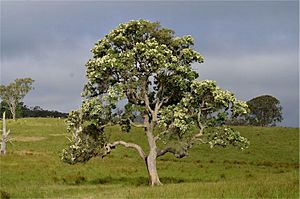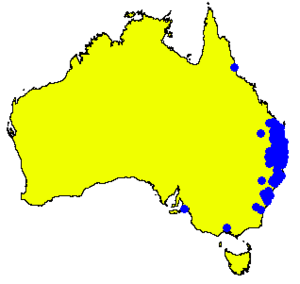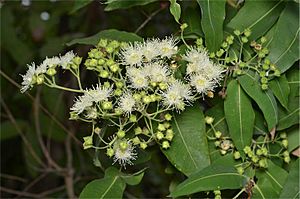Broad-leaved apple facts for kids
Quick facts for kids Broad-leaved apple |
|
|---|---|
 |
|
| Angophora subvelutina near Tenterfield, New South Wales | |
| Scientific classification | |
| Genus: |
Angophora
|
| Species: |
subvelutina
|
 |
|
| Occurrence data from AVH | |
| Synonyms | |
|
|
The Broad-leaved apple (scientific name: Angophora subvelutina) is a special type of tree. It grows only in eastern Australia. This tree has rough bark and leaves that are shaped like a spear or an egg. When it flowers, it has beautiful white or creamy white blossoms. Later, it produces cup-shaped fruits.
Contents
What the Broad-leaved Apple Looks Like
The Broad-leaved apple is a tall tree. It usually grows to be about 17–25 m (56–82 ft) high. This tree has a special part called a lignotuber. This is a woody swelling at the base of the trunk or underground. It helps the tree regrow after a fire.
Bark and Leaves
The tree's trunk and branches have rough, fibrous bark. It often looks flaky and is greyish in color.
Young plants and new shoots (called coppice regrowth) have leaves that sit directly on the stem. This means they are "sessile" and have no leaf stalk. These leaves are egg-shaped or spear-shaped. They are about 50–110 mm (2.0–4.3 in) long and 25–50 mm (0.98–1.97 in) wide. They grow in opposite pairs and wrap around the stem at their base.
Adult leaves also grow in opposite pairs. They are paler on the underside. These leaves are shaped like a spear, an egg, or an oval. They are about 60–120 mm (2.4–4.7 in) long and 20–50 mm (0.79–1.97 in) wide. Like the young leaves, they also wrap around the stem at their base.
Flowers and Fruit
The tree's flower buds grow at the ends of its branches. They are found on a branched stalk called a peduncle, which is about 9–30 mm (0.35–1.18 in) long. Each branch of this stalk holds three or seven buds. These buds are on smaller stalks called pedicels, which are 4–10 mm (0.16–0.39 in) long.
When the buds are ready, they are shaped like a globe. They are about 4–6 mm (0.16–0.24 in) long and wide. The base of the flower, called the floral cup, has ribs. The petals are white or creamy white. They have a green line down the middle and are about 3 mm (0.12 in) long and 3–4 mm (0.12–0.16 in) wide.
The Broad-leaved apple flowers from November to January. After flowering, it produces fruit. The fruit is a cup-shaped capsule. It is about 8–11 mm (0.31–0.43 in) long and 6–11 mm (0.24–0.43 in) wide. The sides of the fruit are ribbed, and the seed-holding parts are enclosed inside.
How it Got its Name
The Broad-leaved apple was first officially described in 1858. This was done by a scientist named Ferdinand von Mueller. He wrote about it in his book Fragmenta phytographiae Australiae.
The second part of its scientific name, subvelutina, comes from Latin. It means "almost velvety."
Where it Grows
The Broad-leaved apple grows in open forests. It prefers rich, fertile soil (called alluvial soil) and gravelly clay.
You can find this tree mainly in areas near the coast. It grows from near Bundaberg in Queensland, south to near Taree in New South Wales. It also grows in a separate, disconnected area near Araluen in New South Wales.
Uses of the Tree
In 1889, a book called 'The Useful Native Plants of Australia’ mentioned something interesting about this tree. It said that "apple trees" were sometimes cut down to help feed cattle during dry seasons. The cattle enjoyed eating the leaves.


